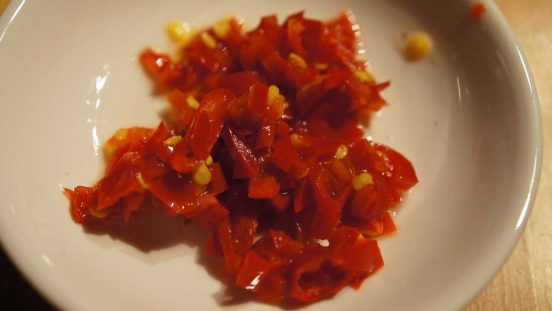Duo lajiao “chopped chilli” is the major “chilli sauce” and preserve of the Hunan kitchen – and extremely easy to make.
You only need to know some of its essentials. And one can learn a lot from it.
Hunan Cuisine
The Hunan kitchen (Xiang cai) is well-known among chinese kitchens for its preference for strong, clear spiciness. The most popular and most important ingredient is fresh chilli, in green or red, depending on the use (mainly, the other ingredients).
And yes, I do mean that chilli is the major ingredient, a main part of the food.
The joke’s going around that a typical dish of the Hunan kitchen were “green chilli, fried with green chilli”… or “red chilli, fried with red chilli.”
This may tell us something about the unpopularity of hot sauces, which we in the West often see as the mainstay of spicy cooking. Hunan tends not to even use chilli oils, let alone any chilli pastes.
No, Hunan cuisine needs the pure chilli.

Preparing Duo Lajiao
Chilli is not always available fresh, however – and what do you do in order to be ready for these times? You make duo lajiao.
The preparation could hardly be easier:
The Chilli
To fill 1-2 medium sized (500 ml) jars, get 500 grams of red chilli. Just make it one of a Hunan-typical fleshy Cayenne type.
The fleshiness is important because no liquid is ordinarily added, it is supposed to be drawn out of the chilli itself. Typical for Hunan are Cayenne-type chile peppers of a middling pungency, so that they are… well, a nicely spicy bit of fun while eating, but also of a pungency that leaves them still well edible.
After all, I’ll say it again, the chilli is a major ingredient which will be eaten, here. It isn’t just some sauce of which a few drops are added over an otherwise finished dish!
Processing
Knife, cutting board, and chilli all need to be well washed. After all, you’ll surely want to work hygienically, and it is believed that getting oil into the duo lajiao will make it spoil, so it needs to be cleaned off.
(Of course, the glasses you want to fill with the duo lajiao need to be cleaned, if not disinfected, as well.)
Chop the chilli roughly (without the stems, ditch those) and layer it into the glass(es), with layers of salt in between. In total, 500 grams of chilli get 50-75 grams of salt.
Or do it like I do and regularly shake the (lid-on ;) ) glasses to distribute the salt around the chilli.
When done with the filling (because there is no more chilli to fill in to the jars no longer empty), put the lid on the jar(s) and leave them in a cool place – or so say many of the few instructions I have found.
When it’s high season for duo lajiao, so my experience, there are no cool places anywhere except in the fridge, so that’s where I put the duo lajiao immediately.
Potential Issues
It usually fermented, at least a bit, anyways – as it should.
Sometimes some of it spoiled (i.e., got moldy), especially when the chilli did not contain enough liquid to get it all covered.
One could experiment with adding a bit of water in such a case, so that all the chilli is submerged in the salt brine; this is not a recommended way to go, though.
Sometimes it ferments only too well, probably with some yeasts. Then, it looks as if it were surrounded by some whitish-transparent slime.
For all I know, it should still be edible even being like that, but it just does not look good like that (and I’d be careful).
Good Duo Lajiao
In the ideal case, the duo lajiao looks simply like chopped chilli floating in a (somewhat) salty brine made up of its own juices and being preserved by that.

Uses and Misunderstandings
“Chilli sauce,” as I labeled it at the very top, it actually is none. That is also apparent from its use, for which it is spooned out.
One can pour some duo lajiao over a finished breakfast noodle soup. Or fry some of it in a bit of oil, add water and salt, and make a broth for that planned breakfast noodle bowl.

Or take a few tablespoonful to prepare chicken pieces, Hunan-Style.
A worse label than that of a chilli sauce or hot sauce is only the one portraying duo lajiao as a chilli preserve with vinegar. It may be like that in other province’s kitchens. Certainly not in Hunan, though!
The iconic Hunan dish calling for duo lajiao, though, is duo lajiao yu (tou), fish (head) with chopped chilli. In preparing that, fish is pan-seared, then finished by steaming it with duo lajiao.
Under good circumstances (when none of the problems mentioned above occur), duo lajiao keeps for a long time. And it provides the fresh, clean flavor of chilli that characterizes Hunan cuisine.

Leave a Reply
You must be logged in to post a comment.